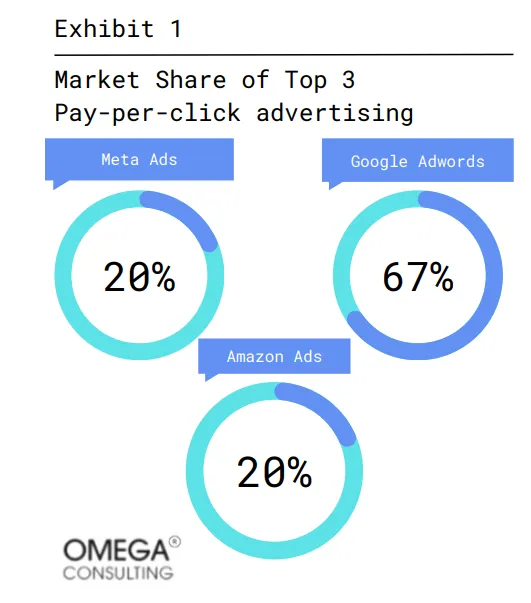- Industries
Industries
- Functions
Functions
- Insights
Insights
- Careers
Careers
- About Us
- Technology
- By Omega Team

Search engine marketing, or SEM for short, is a strategy that uses search engines to boost a website’s visibility or draw users to it. SEM can be used for many purposes, such as acquiring new customers or expanding an existing customer base.
Types of SEM
There are mainly two types of search engine marketing (SEM): paid search advertising and organic search optimization. Paid search advertising, or pay-per-click (PPC) advertising, involves creating and placing ads on search engine results pages (SERPs) that appear when users search for specific keywords. Organic search optimization, also known as search engine optimization (SEO),involves improving a website’s visibility and ranking on SERPs through keyword research, content creation, and link building. Both types of SEM are used to increase website traffic and visibility, but they involve different strategies and tactics.Types of Paid search advertising
There are several types of pay-per-click (PPC) advertising, which include:
Search ads: These are the ads that appear at the top or bottom of a search engine results page (SERP) when a user searches for a specific keyword. They are typically text-based and include a headline, description, and display URL.
Display ads: Website ads are part of a search engine’s advertising network. They can be in the form of text, images, or videos.Shopping ads: These are product listing ads used by e-commerce businesses to promote their products on SERP.
Video ads: These appear on video-sharing platforms, such as YouTube, and are typically in the form of a pre-or mid-roll video.
Social media ads: These ads can be seen on several social media sites, including Facebook, Instagram, and LinkedIn, and can take various forms, including text, image, video, and carousel ads.
Local ads: These ads are targeted to users based on location and can be used to promote a local business or event. All these PPC ads can be managed through advertising platforms such as Google Ads, Bing Ads, and Facebook Ads.

Types of organic search optimization
There are several types of organic search optimization techniques, including:On-page optimization: This refers to optimizing the content and structure of a website to improve its relevance and authority for specific keywords. This includes optimizing title tags, meta descriptions, headings, and other website code elements.
Off-page optimization: This refers to improving the authority and relevance of a website by building backlinks from other websites. Backlinks are links from other sites that point to your site and are considered “votes” of confidence in the quality of your content.
Technical SEO: This refers to optimizing the underlying technical infrastructure of a website to improve its visibility and ranking in search engines. This includes improving site speed, mobile optimization, and ensuring that the website is crawlable by search engine bots.
Content Optimization: This refers to ensuring that the content is helpful, informative and covers the relevant topics of the website. Keyword research refers to identifying the keywords and phrases used to search for services or products related to your business and using those keywords in your website’s content and meta tags. User experience optimization: This refers to improving the overall user experience on your website by making it easy to navigate, fast-loading, and mobile-friendly.
How SEM works?
Search Engine Optimization (SEO) is used to increase a Web site’s visibility in the search engine results page (SERP) by improving its content and HTML coding. Most search engines use automated software known as “spiders” to index web pages. The spiders read each page on the site and extract specific pieces of information from the site, such as the site’s title and description. This information is then stored in the search engine’s database and can be retrieved when the site is listed in response to a search.
Strategies of SEM
SEO strategies can include changing a site’s architecture so that the spider can find the most important pages first, adding keywords to the content and code to increase the relevance ranking of the Web page when it’s listed in response to a search query. This increases the chance that visitors will find your site.Benefits of SEM
Using SEO as part of your search engine marketing strategy has numerous benefits. For one, SEO is relatively inexpensive compared to pay-per-click advertising. While PPC can cost thousands of dollars monthly, SEO is free and can provide long-term benefits.Plus, SEO lets you control the process and optimize your website on your terms. This will enable you to focus your budget on the most effective strategies for reaching your target market and developing relationships with new customers.
Finally, SEO can provide greater visibility for your website and help establish you as a trusted authority in your industry. This means that people searching for solutions to their problems online are likelier to click on your website than your competition’s.
Search engine results pages can be improved by increasing the number of visitors to your site, and the time they spend there. You can do this by writing valuable content that attracts more visitors and keeps them engaged on your site longer by providing them with helpful information. One way to accomplish this is by developing a blog that provides current, relevant information about the topics your readers find most interesting.
You should also post new content regularly to keep your visitors returning and encourage them to share links to your content on social media networks.Most used SEM platforms Businesses may increase their exposure and rating in search engine results pages by utilizing several well-known search engine marketing (SEM) platforms and tools. Some of them include most popular include:
Google Ads: This is the most widely used SEM platform, and it allows businesses to create and run ads on Google search results on pages and other websites that are part of the Google Display Network.
Bing Ads: This is a similar platform to Google Ads, but it allows businesses to run ads on Bing search results pages and other websites that are part of the Bing Network.
Facebook Ads: This social media advertising platform allows businesses to create and run ads on Facebook, Instagram, and other Facebook-owned properties.
Amazon Advertising: This platform allows businesses to create and run ads on Amazon.com and other Amazon properties.
SEMrush: This tool helps businesses research and analyze keywords, track their rankings, and identify opportunities for improvement in their search engine marketing campaigns.
Ahrefs: This tool helps businesses research and analyze backlinks, track their rankings, and identify opportunities for improvement in their search engine marketing campaigns.
Moz: This platform provides tools for keyword research, site auditing, and link building.
ROI from SEM
On average, businesses can expect a return on investment (ROI) of around 200- 300% from their SEM campaigns, meaning that for every dollar spent on ads, they can expect to see two to three dollars in revenue. However, it’s crucial to understand that this is just an average, and some businesses may see much higher or lower returns depending on their circumstances. The revenue generated from SEM can also depend on the targeting of the ads and the industry. For example, a business in a high-ticket sector like real estate may generate more revenue from a single sale than a low-ticket industry like fast food.It’s also important to note that SEM is not a one-time investment; it’s an ongoing process that requires a consistent budget and effort to maintain and improve performance. Giving a specific revenue estimate is difficult without knowing more about a business’s circumstances. However, with a well-planned and executed SEM campaign, companies can expect a significant increase in online visibility and revenue.
Conclusion
Providing quality content is one of the primary goals of search engine marketing (SEM). By developing informative and exciting content that engages your audience and makes them want to return for more, you can position yourself as an expert in your field. Search engines constantly trawl the web in search of fresh content and will favor websites updated frequently with new material pertinent to their intended audience. The more you publish fresh content on your website, the higher you will appear in the search results. It is also essential to ensure your content is optimized for search engines. This means including relevant keywords that your target customers will likely search for in your posts.Subscribe
Select topics and stay current with our latest insights
- Functions